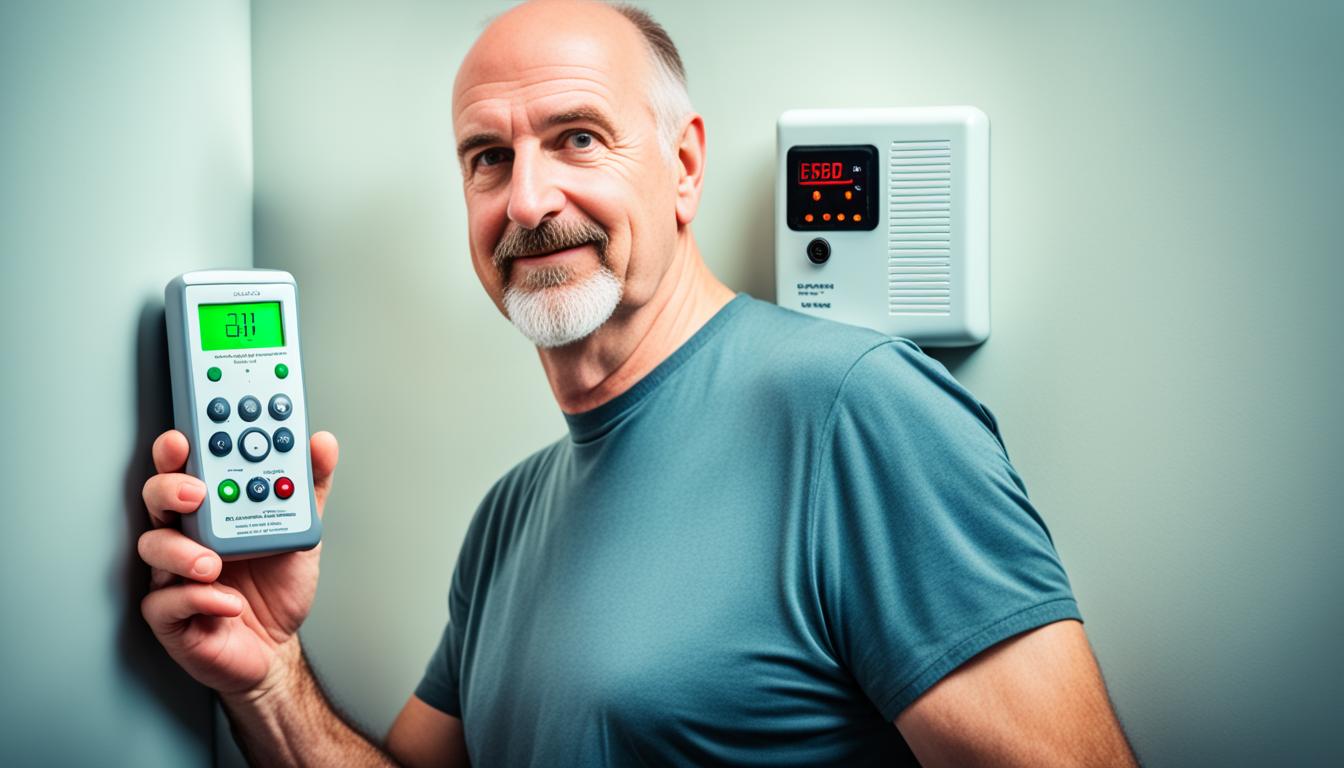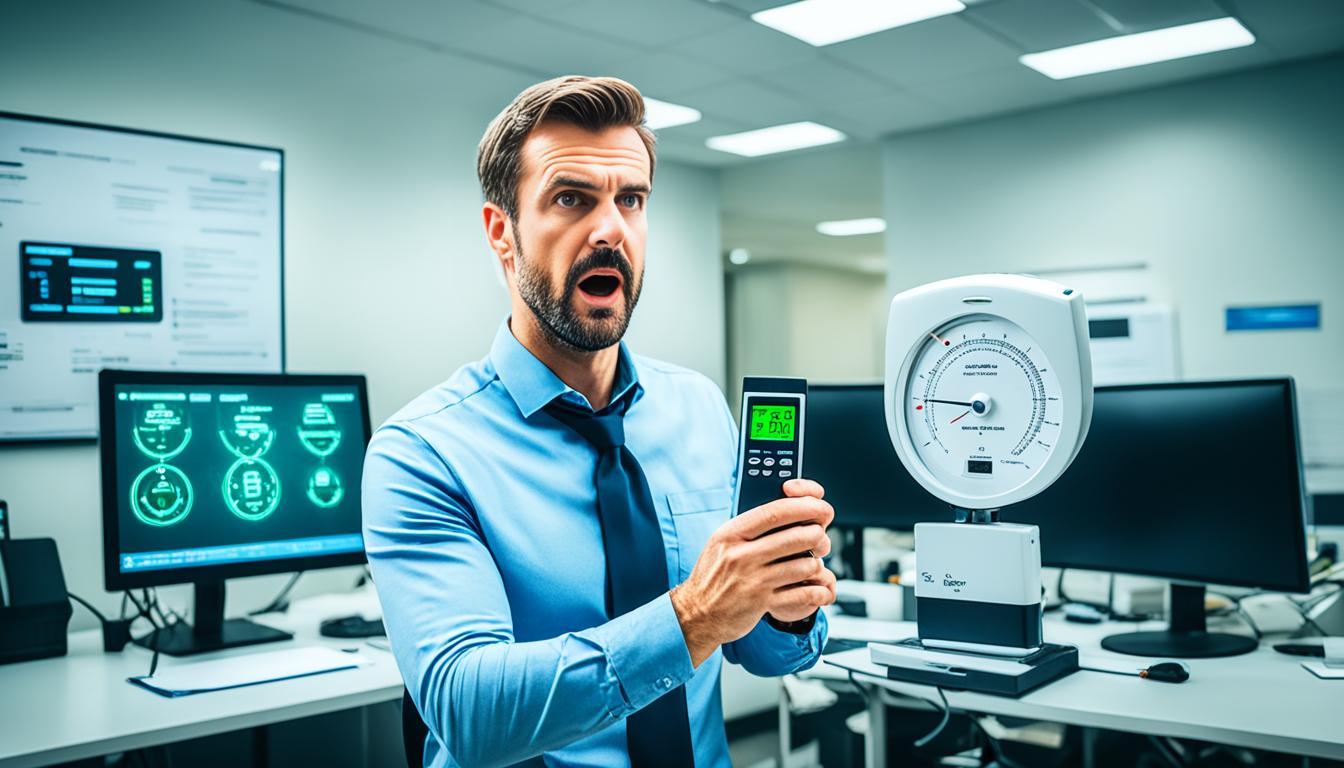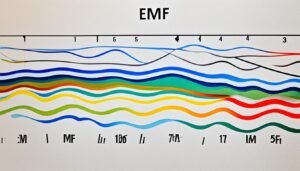Disclosure: This Post Contains Affiliate Links; We earn a commission on purchases.
Conducting accurate EMF measurements is crucial when it comes to assessing electromagnetic field levels. Whether you are concerned about the potential health effects of EMF radiation or need to ensure compliance with safety regulations, accurate measurements are essential. To achieve precise results, it is important to use the right EMF measurement instruments and follow proper assessment techniques. In this step-by-step guide, we will walk you through the process of conducting accurate EMF measurements, providing you with all the information and guidance you need.
Key Takeaways:
- Conducting accurate EMF measurements requires the use of proper measurement instruments and assessment techniques.
- Understanding the basics of EMF measurements, including electromagnetic frequency testing and detection methods, is crucial.
- Choosing the right EMF measurement instrument based on the purpose of the measurement is essential for accurate results.
- Measuring magnetic fields involves using instruments like search coils or fluxgate magnetometers.
- Electric fields can be measured using sensors with parallel conducting plates.
Understanding the Basics of EMF Measurements
Before conducting EMF measurements, it is essential to have a solid grasp of the fundamentals of electromagnetic fields. EMF measurements primarily involve testing the electromagnetic frequency and strength of electric and magnetic fields. By understanding these concepts, one can accurately assess EMF radiation. Different EMF detection methods are employed for measuring magnetic and electric fields.
Magnetic Field Measurement
For magnetic field measurement, several detection methods can be utilized, such as using search coils or fluxgate magnetometers. Search coils measure the voltage induced in a coil of wire when exposed to a magnetic field. On the other hand, fluxgate magnetometers detect magnetic field changes in ferromagnetic materials by employing a technique based on the magnetic hysteresis loop.
Electric Field Measurement
When measuring electric fields, sensors like parallel conducting plates are commonly employed. These sensors determine the electric field strength by measuring the voltage between the plates. The use of parallel conducting plates allows for accurate measurements and helps minimize disturbances that could affect the readings.
By employing suitable EMF detection methods, one can effectively measure both magnetic and electric fields, providing valuable insights into the presence of EMF radiation. Understanding these basics is crucial for conducting accurate electromagnetic field measurements.
Choosing the Right EMF Measurement Instrument
Choosing the right EMF measurement instrument is crucial for accurate measurements. There are various instruments available in the market, such as meters with single or multiple sensors, analog or digital displays, and different frequency response ranges. The size of the sensors and the capability of the instrument to log and calculate various parameters of the field should also be considered. Selecting the appropriate instrument based on the purpose of the measurement is key to obtaining accurate EMF measurements.
Types of EMF Measurement Instruments
When it comes to EMF measurement instruments, it’s important to choose the one that aligns with your specific needs. Here are some common types of instruments used for EMF measurements:
- Meters with Single or Multiple Sensors: These instruments can measure both electric and magnetic fields simultaneously, providing a comprehensive assessment of EMF levels.
- Analog or Digital Displays: Analog meters use a needle to indicate field strength, while digital meters provide precise numerical readings. Choose the display type that suits your preference and ease of use.
- Different Frequency Response Ranges: EMF measurement instruments have specific frequency response ranges. Make sure to select an instrument that covers the frequency range relevant to your measurement needs.
Considerations for Instrument Selection
When choosing an EMF measurement instrument, consider the following factors:
- The purpose of the measurement: Determine whether you need to measure magnetic fields, electric fields, or both. This will help you identify the appropriate instrument for your specific requirements.
- Sensor size: Consider the size of the sensors in the instrument. Smaller sensors offer greater portability and flexibility in placing them in different test locations.
- Logging and calculation capabilities: Some advanced EMF measurement instruments can log data over a period of time and calculate additional parameters such as average, peak, and RMS values. These features can provide more detailed insights into the EMF levels.
Choose Wisely for Accurate Results
By taking the time to choose the right EMF measurement instrument, you can ensure accurate results and reliable assessments of electromagnetic fields. The instrument you select should align with your measurement objectives and provide the necessary capabilities to measure and analyze EMF levels effectively.
Conducting Magnetic Field Measurements
Measuring magnetic fields is an important part of conducting an accurate EMF survey. To capture magnetic field data, various instruments can be used, including search coils, fluxgate magnetometers, and hall-effect devices.
Search coils are commonly used to measure the voltage induced in a coil of wire by a changing magnetic field. These coils are sensitive to magnetic field variations and provide reliable measurements.
Fluxgate magnetometers are another type of instrument used to detect magnetic field changes, particularly in ferromagnetic materials. They operate by using a magnetic core with windings to measure field strength.
Hall-effect devices are semiconductor-based sensors that can measure the transverse Hall voltage across a strip. They provide accurate measurements of magnetic fields and are commonly used in industrial applications.
By using these instruments, you can conduct magnetic field measurements and gather valuable data. Identifying areas with high magnetic field strengths is essential for further investigation and ensuring the safety of individuals exposed to electromagnetic fields.
| Instruments | Measurement Method | Main Features |
|---|---|---|
| Search Coils | Induction of voltage in a coil of wire | – High sensitivity to magnetic field variations – Reliable measurements |
| Fluxgate Magnetometers | Detection of magnetic field changes in ferromagnetic materials | – Accurate measurement of field strength – Suitable for various applications |
| Hall-Effect Devices | Measurement of the transverse Hall voltage | – Semiconductor-based sensor – Precise magnetic field measurement |
By choosing the appropriate instrument and following established EMF survey procedures, you can effectively measure magnetic fields and contribute to creating a safer environment for all.
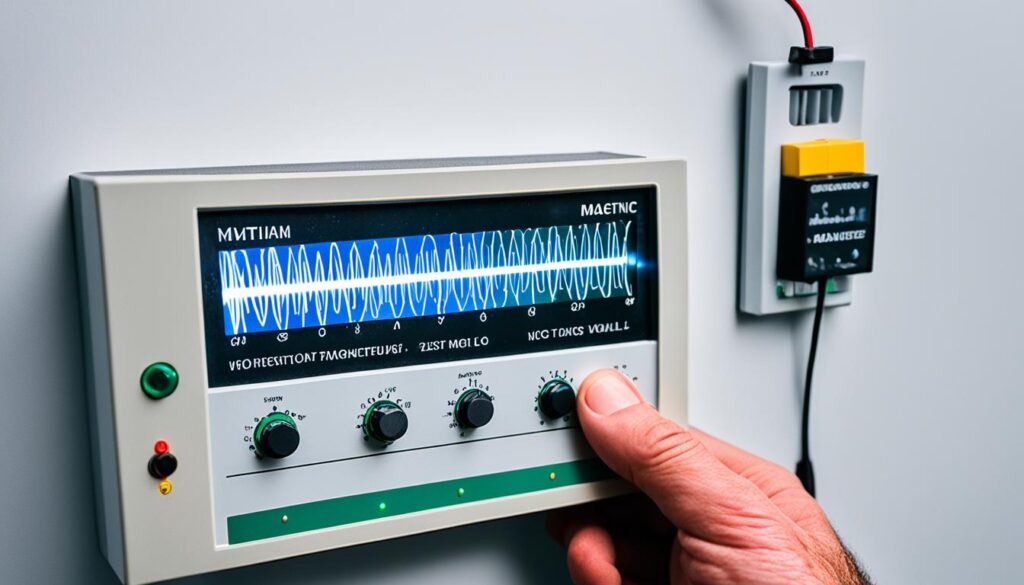
Determining the Correct Instrument for Magnetic Field Measurements
When selecting an instrument for magnetic field measurements, consider factors such as sensitivity, accuracy, and the specific application requirements. Additionally, assess the measurement range, frequency response, and any additional features that may be necessary for your survey. This will help ensure precise and reliable data collection.
Conducting Electric Field Measurements
Measuring electric fields is an important aspect of EMF survey procedures. By accurately assessing electric field strength, you can identify potential areas of concern and take appropriate measures to mitigate any potential risks. To conduct reliable electric field measurements, the use of sensors with parallel conducting plates is common practice. These sensors detect the electric field strength by measuring the voltage between the plates.
To ensure accurate measurements, it is crucial to minimize any interference or perturbation of the electric field caused by the investigator. One effective method is to suspend the meter at a distance from the investigator. This helps to reduce any potential influence or disturbances that might affect the measurements. Alternatively, fixed location measurements can be conducted using a conducting plate. This ensures consistent and precise readings without the need for constant repositioning.
By following these guidelines, you can conduct reliable electric field measurements and obtain accurate data for your EMF assessment. It is essential to prioritize accuracy in order to make informed decisions regarding potential EMF exposure and ensure the safety and well-being of individuals.
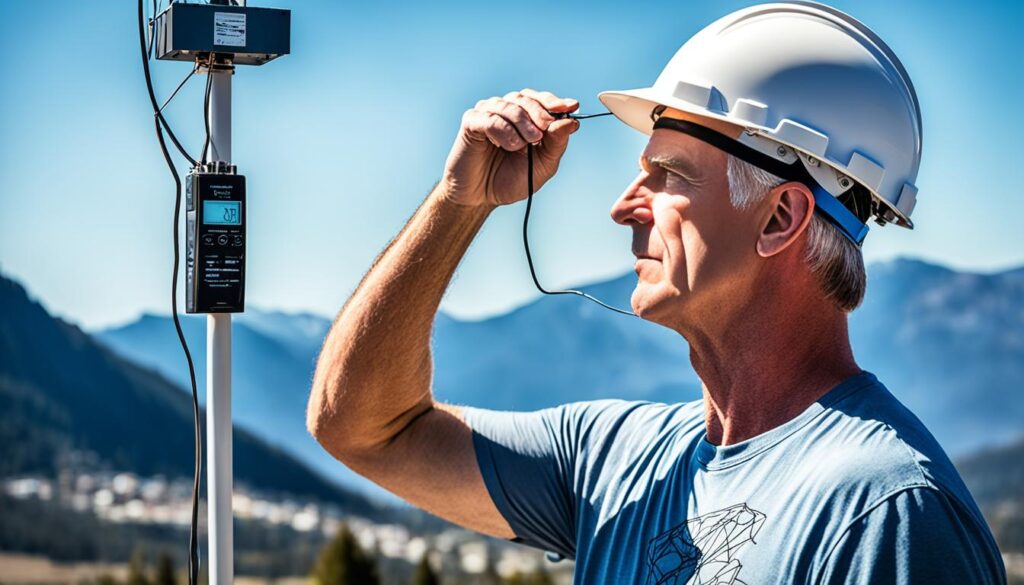
Key Considerations for Conducting Electric Field Measurements
- Use sensors with parallel conducting plates to detect electric field strength.
- Suspend the meter at a distance from the investigator to minimize interference.
- Alternatively, use fixed location measurements with a conducting plate for consistent readings.
By following these procedures, you can gather reliable data on electric field measurements, contributing to a comprehensive EMF assessment and ensuring the safety of individuals in various settings.
| Advantages | Disadvantages |
|---|---|
| Accurate measurement of electric field strength | Potential for interference by investigator |
| Provides valuable data for EMF assessment | Requires proper sensor alignment and positioning |
| Allows for identification of areas requiring further investigation | May require additional equipment for fixed location measurements |
Conducting RF Radiation Measurements
To ensure the accurate assessment of electromagnetic radiation levels, it is crucial to measure radio frequency (RF) radiation emitted by wireless devices. RF meters or antennas specifically designed for RF radiation measurements are used for this purpose. These instruments should be capable of detecting both omnidirectional and focused RF signals, allowing for targeted testing and identification of sources with high power density.
Measuring RF radiation is of utmost importance as it helps evaluate the level of exposure to electromagnetic radiation from wireless devices. By conducting accurate RF radiation measurements, potential health risks can be identified, and appropriate measures can be implemented to minimize exposure. With the advancement of wireless technologies, it has become essential to regularly evaluate RF radiation levels to ensure a safe and healthy environment.
| Instrument | Measurement Range | Features |
|---|---|---|
| RF Meter A | 30 MHz – 6 GHz | • Omnidirectional detection • High accuracy • Data logging capabilities |
| RF Meter B | 1 MHz – 10 GHz | • Focused detection • Real-time measurement display • Internal memory for data storage |
| RF Antenna C | 100 kHz – 18 GHz | • Wide frequency range • Antenna gain adjustment • Easy integration with measurement systems |
When conducting RF radiation measurements, it is essential to select the appropriate instrument based on the desired frequency range and the specific requirements of the assessment. The table above provides a comparison of different RF measurement instruments, their measurement ranges, and key features.
Conclusion
Conducting accurate EMF measurements is crucial for assessing electromagnetic field levels and promoting a safe and healthy environment. By understanding the basics of EMF measurements and selecting the right measurement instrument, you can effectively measure magnetic fields, electric fields, and RF radiation. Following appropriate survey procedures and utilizing reliable detection methods are key to obtaining accurate measurements.
EMF assessment techniques involve conducting magnetic field measurements using search coils, fluxgate magnetometers, or hall-effect devices. Electric field measurements are typically conducted using sensors with parallel conducting plates, while RF radiation measurements require separate meters or antennas capable of detecting both omnidirectional and focused signals.
By consistently applying these electromagnetic field assessment techniques, you can capture a comprehensive understanding of EMF levels and make informed decisions regarding exposure reduction strategies. This empowers individuals and organizations to create safer and healthier living and working environments for all.
Source Links
- https://healthybuildingscience.com/2013/05/30/how-to-measure-emf/
- https://emfacademy.com/how-to-measure-emfs/
- https://www.emfs.info/what/measuring/

Subscribe to Our Newsletter

